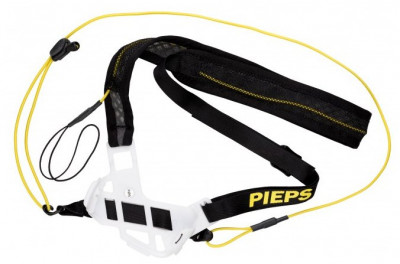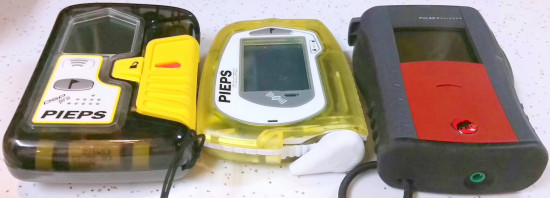The Micro Beacon is the smallest and lightest way to get past gear check at a skimo race. For the 2016/17 season and beyond, the ISMF is requiring three antennas in all avalanche transceivers. This is good news because folks may no longer make a big safety compromise when racing. Although somewhat limited in range, the Pieps Micro beacon is full-featured enough for use in the backcountry where you may actually need it to save a life.
- Smallest & lightest three-antenna beacon on the market.
- Patented sensor technology improves ease of use & handling.
- Multiple burials can be flagged so you can focus on just one.
- Relatively large display makes it easy to read in low light.
- Software can be updated using a mobile app with Bluetooth®.
- Search strip width of 50m is impressive for the small beacon.
- Includes lightweight chest harness (65g), a bonus elastic tether (9g), and an alkaline battery (23g)
Update 2019/20: Pieps removed the proximity sensor which forced this beacon into search mode every time it was removed from its carrying harness. Now in this "Micro Button" version, a manual button-press switches between modes and thus eliminates unwanted cases of mode change.
| Specifications | |
|
Weight |
152g w/ 1 AA battery |
| Antennas | 3 digital |
| Transmit Range | 50m |
| Search Range | 50m |
| Number of Victims | 3 |
| Battery Life | 200 hours |
| Specs Verified | Yes |
| Skimo Co Says | |
| Usage | ISMF certified beacon |
| Notes | Uses a button to switch to search mode |
| Bottom Line | Smallest and lightest full-featured beacon |
| Compare to other Beacons | |
Questions & Reviews
I'm a fan of this beacon. The range is average, but more than makes up for it in diminutive size, and a large screen. On/off switch is simple and straightforward, and send to search is reliable once you get used to it. Also a fan of the single aaa battery, I waste many fewer batteries this way.
The perfect beacon for riding in a pocket.
Once the newness wore off, however, this beacon has limited use beyond racing, and didn’t seem worth keeping around. The proximity bag doesn’t have a good way to stay affixed to the beacon, so is prone to running away. The glitchiness of the prox sensor is also frustrating when you just want to go skiing, and your beacon is holding you up with noises and wanting to switch modes.
I also want to be able to hand any beacon to a friend and have them be able to find me, and unfortunately this does not allow for intuitive, foolproof use with a bunch of symbols and only one button.
I’d recommend saving some headache and dollars and going with a simple, small beacon like the BCA Tracker 3, and leaving this one to the WC racers.
Thx
The weight differentials among beacons are trivial given that the weight is carried on your torso, but the smaller size for this model is immediately noticeable. The attached picture shows the Micro between a Pieps DSP and a Barryvox Pulse. Not only are the width and height significantly slimmed down on the Micro, but the depth is far (far) less, which makes a big difference for comfort in your race suit's interior pocket. (The width, height, and overall shape just happen to be nearly identical to the long-discontinued Barryvox Opto 3000 -- until now the smallest & lightest multiple-antenna beacon -- but the depth of the Micro is also smaller than the Opto 3000.)
Five Stars also even aside from the size and weight, but with one very important caveat: the automated switchover between Transmit <> Search requires that you read the user manual carefully (and realized that the use of "Blocked" is an unfortunately word choice when "Locked" is really intended), understand the screen icons (some of which are not intuitive), and think through some of the situations that trigger the switchover.
So if you're the kind of person who gets confused by your current beacon's controls and/or display, then this is NOT the beacon for you: you could end up in the wrong mode, and moreover not even realize it.
Otherwise, the automated switchover is really neat in what will probably be something like 99% of the time, but you have to be aware of that remaining 1%. And everything else about the beacon is competitive, despite the diminutive size and weight.
The reason is that the proximity sensor might not have anything in, well, proximity even if the beacon is in a race suit or pant pocket.
For example, when preparing for a race, I turned on the beacon, placed it in my race suit, and done!
Or so I thought.
A few moments later, I unzipped my suit to tuck in my back-up skins and ... eek, I was suddenly searching for all my fellow racers in the lodge! This happened because the material on the inside of the race suit beacon flap apparently didn't make the proximity sensor happy, and with the suit unzipped, the sensor wasn't up against my body either.
Fortunately with the little carry bag, the proximity sensor was once again happy, and the beacon stayed in transmit.
As of the time of this December 2019 addendum, I have not yet tested the new "Button" version with a more traditional switch.
The new switch works really well IF you know how to use it. Otherwise, you'll probably never figure it out: I've tested almost every single beacon on the market since the mid aughts, and I couldn't figure it out until I read the user manual.
(I test beacons first before reading the manual in an attempt to determine how intuitive everything else.)
And the answer is ... you have to think of the Flag button really as a Confirm button.
So press the mode button, then during the countdown that appears with the Flag icon, press the Confirm button. As long as you remember that, it's easy!
Earn store credit by writing reviews. Learn more.















